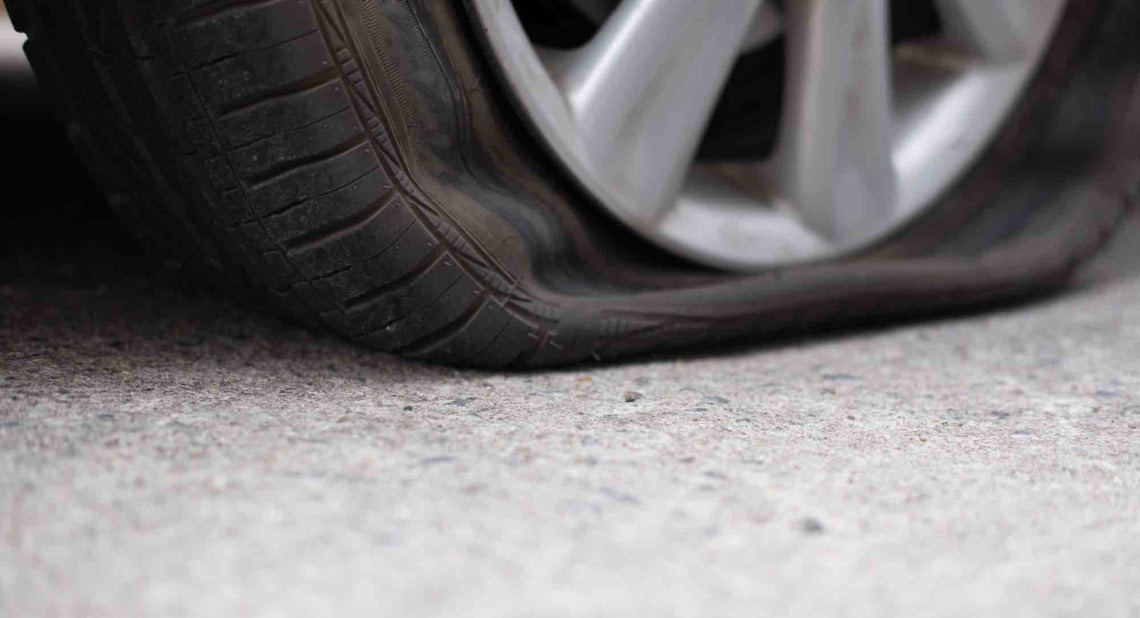Whether you don’t spot them in time or there’s simply no way to drive around them, sometimes potholes can’t be avoided. It’s a common road hazard that many drivers come across almost everyday, however these road imperfections could be more damaging than you think. Not only can driving over potholes damage your tyres, but it can also cause problems with your car’s steering, suspension and wheel alignment, and it can even cause fluid leaks. With this in mind, our Scheme partner Kwik Fit put together a list of four pothole safety tips that all drivers should know.
1. Make sure your tyres are in good condition
One way to reduce the risk of damage to your car from potholes is to make sure your tyres are in good condition. Perhaps most importantly, they need to have the correct pressure. Properly inflated tyres give extra protection against impacts and can help to minimise any damage. It’s worth bearing in mind that tyres with too much or too little air generally fare worse when confronted with uneven road surfaces. To find out what the recommended pressure for your tyres is, check behind the driver’s door, under the fuel cap or in the owner’s manual. Legally, tyres need to be replaced when the tread depth falls to 1.6mm on 75% of the contact surface. However Kwik Fit will replace tyres on Motability Scheme cars when the depth falls to 2.0mm. You should also look out for any bulges or excessive wear in the sidewall, as tyres with these problems won’t hold up well either.
It’s important to make sure your car is serviced regularly, which is included in your 3 year lease package so if you suspect any problems with your steering or suspension, contact your dealer to get your vehicle looked at by an expert. Check that your lights are working properly too, and make sure your windscreen wipers are functioning well and your windscreen washer fluid is always topped up. If you keep your car in good condition, it can help you to avoid potholes in the first place, as well as cushioning the impact if it’s unavoidable. Remember, a well maintained car can help you to steer clear of all sorts of other hazards as well, not just potholes.
2. Practice good driving habits
Practicing safe and responsible driving should be done at all times, but there are a few habits that are particularly helpful for avoiding potholes. While the simplest solution is to drive around them, this isn’t always possible, especially in the dark or when they’re not clearly visible. As long as it’s safe to do so, one way to lessen the damage is to slow down if you see a pothole ahead. The slower you’re driving, the less impact there’ll be on your tyres and suspension.
You should also try to maintain enough space between you and the vehicle in front at all times. This will allow you to clearly see the road ahead and keep an eye out for any rough surfaces. Where possible and safe, drive around puddles too as there could be holes hidden beneath patches of water. This road damage is often caused by water that seeps through cracks, so there’s a significant chance that you’ll find cavities lurking underneath puddles.
It’s also sensible to avoid roads that are known for being in poor condition. If possible, try to take a different route, particularly if you know that a road has a lot of uneven surfaces. Even though the journey might take you longer, it could save you from having to fork out for costly repairs and more importantly, reduce the risk of an accident.
3. Keep a firm hold on the steering wheel
When driving over a pothole, make sure you keep a firm grip on the steering wheel to remain in control of the car. The dip in the road can cause your vehicle to change direction suddenly, which can be dangerous for yourself and other road users. Straightening your wheels will also mean you hit the road defect head on, which is better than making contact at an angle as this can cause more damage to your wheels. Braking directly over the hole is not recommended. If you haven’t managed to slow down beforehand, try to continue at the same speed over it rather than braking.
It’s also important not to swerve at the last minute. Even though this may be your natural reaction to avoid inflicting damage on your car, it can be dangerous if you veer into another lane. Making sudden turns also means that you’re more likely to hit the hole at an angle.
If you think that a wheel, tyre or another part of your car has been damaged after making contact with a cavity, slow down and pull over in a safe place to inspect your vehicle. It may be that you have a flat or punctured tyre, or another problem, and need to call for assistance.
4. Know the common signs of pothole damage
Some of the most obvious signs of pothole damage are punctures, bulges in the tyre sidewall or dents in the wheel rim. Other common indicators include fluid leaks, wear underneath the car or an unusual noise coming from the exhaust. Your car may also start to pull to one side, or there might be uneven wear on your tyres. Both of these issues could signal a problem with the wheel alignment. You may also feel as though the car is bouncing slightly, which could mean that something is wrong with the suspension.
If you notice any of these issues, take your car to your dealer to get it checked out as soon as possible. It may be that you need your tyres replacing, rebalancing or realigning. Bear in mind that the sooner these problems are dealt with, the less chance there is of them developing into more serious problems in the future.
By properly maintaining your vehicle and practicing safe driving habits, you stand a much better chance of minimizing the damage caused by potholes or avoiding them altogether. If you come across a cavity in the road that is particularly large or deep, it may also be worth reporting it to your local council so it does not pose a risk to other motorists in the future.
Kwik Fit and the Motability Scheme
With tyre replacement included as part of your lease agreement, Kwik Fit can get you back on the road as quickly and safely as possible. Puncture repairs, wheel balance and replacement of stolen or vandalised tyres is also included in the lease package. There are 607 Kwik Fit centres across the UK, all open seven days a week. If you are a Scheme customer and would like to book an appointment, you can do so here.
Find your nearest Kwik Fit Centre
Want to find out more about the Scheme?
If you are not a Motability Scheme customer and would like to find out more about what’s included in the lease, request an information pack below.
Related articles
How to choose the right tyres for you
7 simple tips to keep your tyres in good condition
Time for new tyres? It’s easier than you think with Kwik Fit’s online booking service
![]()





